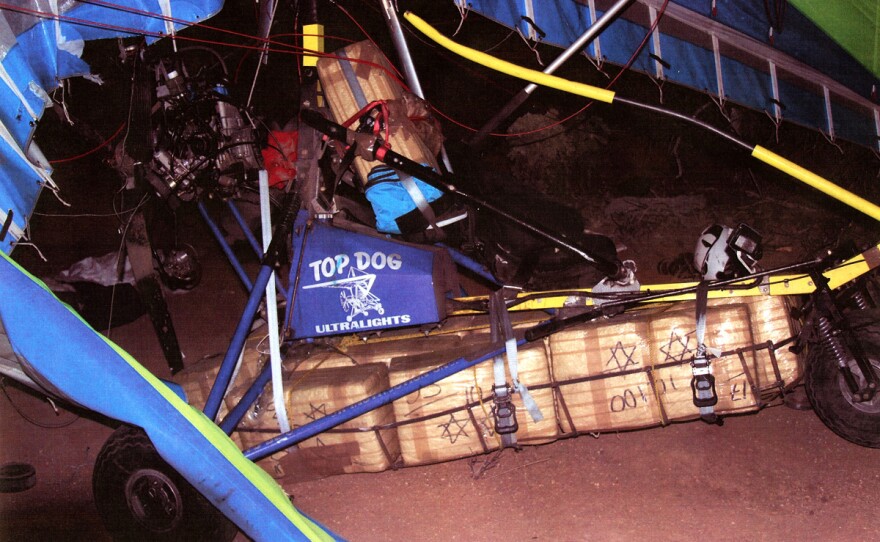Enforcement pressure on the ground by U.S. agents has forced Mexican drug traffickers to get creative.
Smugglers are using ultralight aircraft to drop a few hundred pounds of marijuana into the United States at a time. It’s just one more method in a smuggling portfolio that is constantly changing, according to the U.S. Border Patrol and Immigration and Customs Enforcement (ICE) officials.
The preferred areas to operate in are rural spots along the U.S.-Mexico border.
This includes the hilly terrain outside of Nogales, Ariz., where ICE agents recently scanned the darkened horizon for ultralights. With a sliver of a moon above the mountains, ICE’s Kevin Kelly said this is the type of place where pilots have dropped loads of pot.
“Right now, you’re in one of the key marijuana smuggling corridors in the country,” said Kelly, who runs the ICE office in Nogales.
In the air, ultralights look like flying lawnmowers.
The federal government says the number of ultralights illegally crossing into the United States from Mexico – at least the ones they know about – nearly doubled from 118 in 2009 to 228 last year. In that time, Arizona agents alone have sized 10 aircraft and about 11,000 pounds of marijuana – a drop in the bucket.
“It’s a quick jaunt. They usually know where they’re going,” Kelly said. “And they maneuver it in such a way that they can get into the U.S., drop their load and get back to Mexico very quickly.”
“In my mind, it’s awesome. Pilots have a lot of guts,” Acevedo said. “How they can come in and successfully drop 280 pounds of marijuana basically on somebody’s lap.”
These pilots often fly on one seat, exposed to the air, attached to a glider wing and a 25-horsepower engine. With about three gallons of gas in the tank, their range is no more than a few dozen miles.
Recently at the Chandler Municipal Airport outside of Phoenix, Pilot Steve Bass wheeled his two-seat trike onto the tarmac. The model is slightly bigger than a traditional ultralight, but with the wind gusting at more than 20 mph, Bass said it was still too dangerous to do anything but taxi around and show off the engine.
Legitimate pilots say ultralights are safe, and they worry that drug traffickers are giving the hobby a bad name. But flying at night, in the wind, and skirting over canyons in the desert, is a much different story than using an ultralight for pleasure.
“Plus they have a payload on board and all of a sudden they’re 200 pounds lighter,” Bass said. “And it’s more difficult to control in the wind at night.”
At least two ultralights have crashed in Arizona since smugglers started using them in earnest. In 2008, one did a pirouette into a lettuce farm, leaving the pilot’s body twisted in the wreckage.
ICE’s Kelly said it’s all about the money. For delivering a package in the desert worth $160,000 in Phoenix, a pilot might go home with $2,000. Kelly said it’s a cost-effective way to smuggle drugs.
“That’s not a big hit for the drug trafficking organization,” Kelly said. “Drug traffickers can get it across quick and fast.”
This is a problem that is now being seen across the U.S.-Mexico border.
Late last year, the San Diego area recorded its first ultralight incursion. Since then, Deputy Special Agent in Charge Joe Garcia said his ICE office has confirmed about six total, mostly in the rural Otay Mountains east of the urban areas.
Further east in El Centro, Calif., agents have logged 30 cases, nearly all of them in the past several months. When the government beefed up the border fence in El Centro, it reduced vehicle smuggling through the desert. Garcia said that’s forced traffickers to adapt.
“We’ve driven them underground with tunnels. We’ve driven them out to sea,” Garcia said. “And now they’re in the air. Why not try something new?”
And that’s the consistent message from federal agents. The cartels keep trying one method after another. Ultra-lights bring in just a few hundred pounds of pot at a time into the United States. But for now the method works. And it’s proof that even illegal business will look for ways to diversify.






